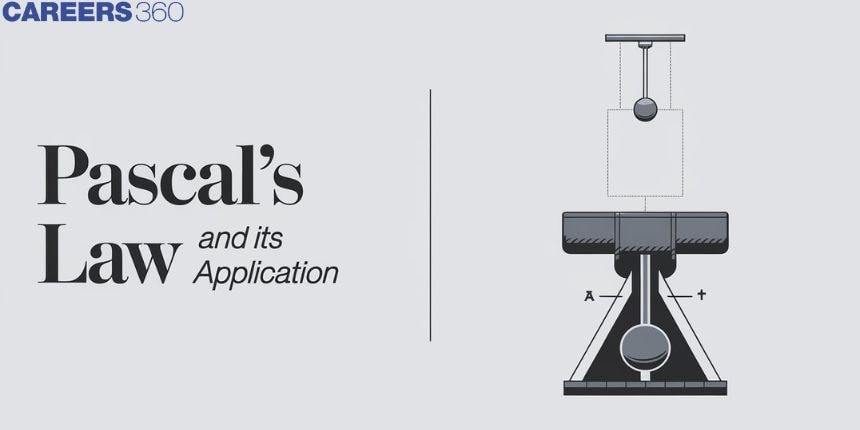Pascals Law and its Application - Definition, Formula, Applications, FAQs
Pascal's Law is one of the basic principles of fluid mechanics. This principle was coined by Blaise Pascal and is the basis of many hydraulic systems and devices. The principle is such that it can be used in diesel engines, hydraulic lifts, brakes, presses, etc.; that is, even in your everyday life, it will find application in engineering efficiencies such as force transmission and multiplication. This is where the strength of fluid mechanics may be showcased in terms of real-world problems, solved with a lot of precision and indeed much efficiency.
JEE Main/NEET 2027: Physics Important Formulas for Class 10
NEET 2025: Mock Test Series | Syllabus | High Scoring Topics | PYQs
JEE Main: Study Materials | High Scoring Topics | Preparation Guide
JEE Main: Syllabus | Sample Papers | Mock Tests | PYQs

Pascal Law Definition
Pascal's Law states that "The pressure externally applied on a confined liquid is transmitted or distributed uniformly through the entirety of liquid in all directions".
Static pressure acts perpendicular to any surface in contact with the fluid. Pascal also found that at a point, the pressure would be the same across any arbitrary planes passing through that point within that fluid for the case of a static fluid. Pascal's law is also referred to as Pascal's principle or principle of transmission of fluid pressure. This law was formulated in 1653 by French mathematician Blaise Pascal.

Also, read
- NCERT Notes For All Subjects
- NCERT Exemplar Solutions for All Subjects
- NCERT Solutions for All Subjects
Pascal Law Formula
Pascal's law is expressed as follows:
$$
F=P A
$$
Where,
F is the applied force, while P is the transmitted pressure.
A represents the cross-sectional area.
Derivation of Pascal Law
Consider a right-angled triangle in a liquid of density. Due to the small size of the element, each point is presumed to be at the same depth as the liquid surface. Gravity has the same effect at all of these locations.

Let $a b$, bd, and cd represent the cross-sectional areas of the ABFE, ABDC, and CDFE faces, respectively.
Let P1, P2, and P3 represent the pressures communicated on the faces $A B F E, A B D C$, and CDFE, respectively.
The pressure exerts a force parallel to the surface. Allow P1 to apply force F1 to the surface ABFE, P2 to apply force F2 to the surface ABDC, and P3 to apply force F3 to the surface CDFE.
Here,
$F_1=P_1 \times$ area of $A B F E=P_1 \mathrm{ab}$
$F_2=P_2 \times$ area of $A B D C=P_2$ bd
And, $F_3=P_3 \times$ area of $C D F E=P_3 c d$
We also know that,
$$
\begin{aligned}
& \sin \theta=\frac{b}{a} \\
& \cos \theta=\frac{c}{a}
\end{aligned}
$$
The prism's net force will be zero because the prism is in equilibrium.
$$
\begin{aligned}
& F_1 \sin \theta=F_2 \\
& F_1 \cos \theta=F_3
\end{aligned}
$$
Pressure is expressed as,
$$
\begin{aligned}
& P_1 a d b / a=P_2 b d(\text { equation-i) } \\
& P_1 a d c / a=P_3 c d \text { (equation-ii) }
\end{aligned}
$$
From (i) and (ii),
$$
\begin{gathered}
\mathbf{P}_1=\mathrm{P}_2 \text { and } \mathrm{P}_1=\mathbf{P}_3 \\
\therefore \mathrm{P}_1=\mathrm{P}_2=\mathrm{P}_3
\end{gathered}
$$
|
Related Topics |
Applications of Pascal's law
1. Fluid Lift
It has many applications in everyday life. Many devices, such as hydraulic lifting and pressure brakes, are based on Pascal's law. The liquid is used to transfer pressure to all these devices. In a hydraulic lift, the two pistons are separated by a space filled with liquid. The cross-section piston at the small cross A is used to apply force F directly to that liquid. The pressure P = F / A is transferred across the liquid to a larger cylinder fitted with a large area piston B, resulting in a higher force of (P × B. ). Platform B can be moved up or down. Therefore, the force used is increased by the B / A factor
2. Brake Fluid
In automobiles, pressure brakes also serve the same purpose. When using less force on the foot, the master piston moves inside the master cylinder, and the resulting pressure is transferred by the oil brakes to form a larger area piston. A high force was then applied to the piston and it was pulled down, stretching the braces on the brake line. As a result, the small force at the base produces excessive force returning to the wheel. The main advantage of the system is that the pressure, which is stopped by pressing the pedal, is transmitted evenly across all cylinders, attached to four wheels to make the braking effort equal to all the wheels.
Frequently Asked Questions (FAQs)
According to Pascal's law, "Stable external pressure applied to a closed fluid is still distributed or evenly distributed throughout the fluid in all directions."
Hydraulic lift functions according to the Pascal Act.
Pascal's law applies to gas. Pascal's law is also known as pascal’s principle of the transfer of pressure (whether water or gas).
French mathematician Blaise Pascal enacted Pascal's law in 1653.
Pascal's law states that pressure applied to a closed fluid will be transferred without a change in the size of the entire liquid and the walls of the vessel. The pressure at any time in the liquid is equal on all sides.
Also Read
24 Dec'24 05:57 PM
16 Nov'24 11:39 AM
12 Nov'24 11:51 PM
12 Nov'24 09:36 PM
12 Nov'24 09:16 PM
11 Nov'24 07:25 PM
11 Nov'24 06:00 PM
05 Nov'24 07:02 AM
26 Sep'24 11:28 AM